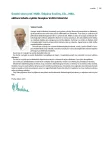Progress in the development of insulin pumps and their advanced automatic functions
Authors:
Martin Prázný
Authors‘ workplace:
III. interní klinika 1. LF UK a VFN Praha, přednosta prof. MUDr. Štěpán Svačina, DrSc., MBA
Published in:
Vnitř Lék 2015; 61(4): 355-357
Category:
Reviews
Overview
Patients with type 1 diabetes are exposed to permanent burden consisting of careful glucose self-monitoring and precise insulin dosage based on measured glucose values, carbohydrates content in the food and both planned and non-planned physical activity. Erroneous insulin dosing causes frequent both hypoglycemia and hyperglycemia. Hypoglycemia is, however, the most clinically significant complication limiting the optimal diabetes control. Automatic features for insulin dosage integrated in insulin pumps are thus very important. Low glucose suspend (LGS) and Predictive Low Glucose Management (PLGM) use glucose sensor values to prevent hypoglycemia, shorten the time spent in hypoglycemic range and present further step forward to fully closed-loop system of insulin treatment.
Key words:
closed-loop system – continuous glucose monitoring – predictive low glucose management – pumps – sensors
Sources
1. Cryer PE. Hypoglycemia in type 1 diabetes mellitus. Endocrinol Metab Clin North Am 2010; 39(3): 641–654.
2. Maahs DM, Chase HP, Westfall E et al. The effects of lowering nighttime and breakfast glucose levels with sensor-augmented pump therapy on hemoglobin A1c levels in type 1 diabetes. Diabetes Technol Ther 2014; 16(5): 284–291.
3. Nimri R, Muller I, Atlas E et al. MD-Logic overnight control for 6 weeks of home use in patients with type 1 diabetes: randomized crossover trial. Diabetes Care 2014; 37(11): 3025–3032.
4. Brown SA, Kovatchev BP, Breton MD et al. Multinight “bedside” closed-loop control for patients with type 1 diabetes. Diabetes Technol Ther 2015; 17(3): 203–209.
5. Nimri R, Muller I, Atlas E et al. Night glucose control with MD-Logic artificial pancreas in home setting: a single blind, randomized crossover trial-interim analysis. Pediatr Diabetes 2014; 15(2): 91–99.
6. Danne T, Kordonouri O, Holder M et al. Prevention of hypoglycemia by using low glucose suspend function in sensor-augmented pump therapy. Diabetes Technol Ther 2011; 13(11): 1129–1134.
7. Choudhary P, Shin J, Wang Y et al. Insulin pump therapy with automated insulin suspension in response to hypoglycemia: reduction in nocturnal hypoglycemia in those at greatest risk. Diabetes Care 2011; 34(9): 2023–2025.
8. Bergenstal RM, Klonoff DC, Garg SK et al. Threshold-based insulin-pump interruption for reduction of hypoglycemia. N Engl J Med 2013; 369(3): 224–232.
9. Danne T, Tsioli C, Kordonouri O et al. The PILGRIM study: in silico modeling of a predictive low glucose management system and feasibility in youth with type 1 diabetes during exercise. Diabetes Technol Ther 2014; 16(6): 338–347.
Labels
Diabetology Endocrinology Internal medicineArticle was published in
Internal Medicine

2015 Issue 4
Most read in this issue
- Myokines – muscle tissue hormones
- The treatment of diabetes in patients with liver and renal impairment
- Treatment of GLP1 receptor agonists and body mass control
- Treatment of hypertension in diabetes mellitus
